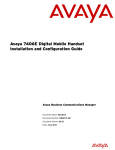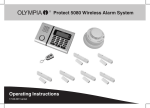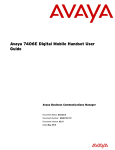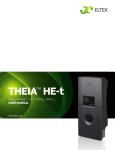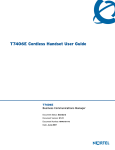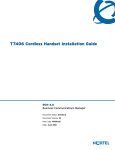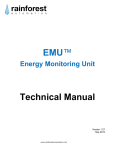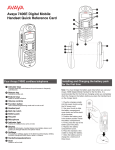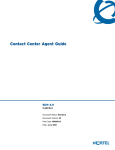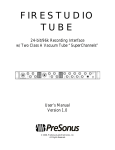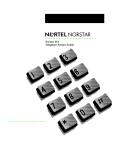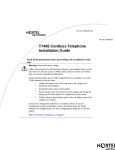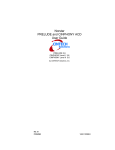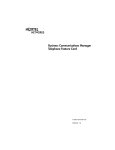Download Avaya T7406E Configuration Guide
Transcript
T7406E Cordless Handset Installation and Configuration Guide T7406E Business Communications Manager Document Status: Standard Document Version: 01.02 Part Code: NN40110-301 Date: October 2007 Copyright © Nortel Networks 2007, All rights reserved. The information in this document is subject to change without notice. The statements, configurations, technical data, and recommendations in this document are believed to be accurate and reliable, but are presented without express or implied warranty. Users must take full responsibility for their applications of any products specified in this document. The information in this document is proprietary to Nortel Networks. Trademarks Nortel, the Nortel logo, and the Globemark are trademarks of Nortel Networks. Microsoft, MS, MS-DOS, Windows, and Windows NT are registered trademarks of Microsoft Corporation. All other trademarks and registered trademarks are the property of their respective owners. Contents 3 Contents How to get help . . . . . . . . . . . . . . . . . . . . . . . . . . . . . . . . . . . . . . . . . . . . . . . . 7 Chapter 1 What’s new . . . . . . . . . . . . . . . . . . . . . . . . . . . . . . . . . . . . . . . . . . . . . . . . . . . . 9 Handset features . . . . . . . . . . . . . . . . . . . . . . . . . . . . . . . . . . . . . . . . . . . . . . . . . . . . . . 9 Three-line LCD . . . . . . . . . . . . . . . . . . . . . . . . . . . . . . . . . . . . . . . . . . . . . . . . . . . . 9 One-touch indicator keys . . . . . . . . . . . . . . . . . . . . . . . . . . . . . . . . . . . . . . . . . . . . 9 Choice of ring tones . . . . . . . . . . . . . . . . . . . . . . . . . . . . . . . . . . . . . . . . . . . . . . . . 9 20-name directory . . . . . . . . . . . . . . . . . . . . . . . . . . . . . . . . . . . . . . . . . . . . . . . . . 10 Battery level indicator . . . . . . . . . . . . . . . . . . . . . . . . . . . . . . . . . . . . . . . . . . . . . . 10 Base station features . . . . . . . . . . . . . . . . . . . . . . . . . . . . . . . . . . . . . . . . . . . . . . . . . . 10 Wall- or ceiling-mountable . . . . . . . . . . . . . . . . . . . . . . . . . . . . . . . . . . . . . . . . . . . 10 Colored LED status indicators . . . . . . . . . . . . . . . . . . . . . . . . . . . . . . . . . . . . . . . . 10 Security and encryption . . . . . . . . . . . . . . . . . . . . . . . . . . . . . . . . . . . . . . . . . . . . . 10 Antenna diversity . . . . . . . . . . . . . . . . . . . . . . . . . . . . . . . . . . . . . . . . . . . . . . . . . . 10 USB to UART bridge controller . . . . . . . . . . . . . . . . . . . . . . . . . . . . . . . . . . . . . . . . . . 11 Chapter 2 Introduction . . . . . . . . . . . . . . . . . . . . . . . . . . . . . . . . . . . . . . . . . . . . . . . . . . 13 Specifications . . . . . . . . . . . . . . . . . . . . . . . . . . . . . . . . . . . . . . . . . . . . . . . . . . . . . . . 13 Installation considerations . . . . . . . . . . . . . . . . . . . . . . . . . . . . . . . . . . . . . . . . . . . . . . 14 Operational bandwidths . . . . . . . . . . . . . . . . . . . . . . . . . . . . . . . . . . . . . . . . . . . . 14 Radio frequency local area networks . . . . . . . . . . . . . . . . . . . . . . . . . . . . . . . . . . 14 Operational parameters . . . . . . . . . . . . . . . . . . . . . . . . . . . . . . . . . . . . . . . . . . . . 15 Telephone-to-base range . . . . . . . . . . . . . . . . . . . . . . . . . . . . . . . . . . . . . . . . . . . 15 Radio range and coverage considerations . . . . . . . . . . . . . . . . . . . . . . . . . . . . . . 15 Density and interference . . . . . . . . . . . . . . . . . . . . . . . . . . . . . . . . . . . . . . . . . . . 15 Installation site parameters . . . . . . . . . . . . . . . . . . . . . . . . . . . . . . . . . . . . . . . . . . 15 Environment layout considerations . . . . . . . . . . . . . . . . . . . . . . . . . . . . . . . . . . . . 16 Handset overview . . . . . . . . . . . . . . . . . . . . . . . . . . . . . . . . . . . . . . . . . . . . . . . . . . . . 18 Monitoring handset signal strength . . . . . . . . . . . . . . . . . . . . . . . . . . . . . . . . . . . . 18 Handset features . . . . . . . . . . . . . . . . . . . . . . . . . . . . . . . . . . . . . . . . . . . . . . . . . . . . . 19 Indicator keys . . . . . . . . . . . . . . . . . . . . . . . . . . . . . . . . . . . . . . . . . . . . . . . . . . . . 21 Dial pad character mapping . . . . . . . . . . . . . . . . . . . . . . . . . . . . . . . . . . . . . . . . . 21 Programming mode menus . . . . . . . . . . . . . . . . . . . . . . . . . . . . . . . . . . . . . . . . . . . . . 21 Battery pack overview . . . . . . . . . . . . . . . . . . . . . . . . . . . . . . . . . . . . . . . . . . . . . . . . . 23 External battery charger . . . . . . . . . . . . . . . . . . . . . . . . . . . . . . . . . . . . . . . . . . . . 24 Base station overview . . . . . . . . . . . . . . . . . . . . . . . . . . . . . . . . . . . . . . . . . . . . . . . . 25 Base station features . . . . . . . . . . . . . . . . . . . . . . . . . . . . . . . . . . . . . . . . . . . . . . 26 T7406E Cordless Handset Installation and Configuration Guide 4 Contents LED status indicators . . . . . . . . . . . . . . . . . . . . . . . . . . . . . . . . . . . . . . . . . . . . . . 28 DIP switches . . . . . . . . . . . . . . . . . . . . . . . . . . . . . . . . . . . . . . . . . . . . . . . . . . . . . 28 Wiring charts . . . . . . . . . . . . . . . . . . . . . . . . . . . . . . . . . . . . . . . . . . . . . . . . . . . . . 29 Additional components . . . . . . . . . . . . . . . . . . . . . . . . . . . . . . . . . . . . . . . . . . . . . . . . 30 Battery charge controller . . . . . . . . . . . . . . . . . . . . . . . . . . . . . . . . . . . . . . . . . . . . 30 Handset power . . . . . . . . . . . . . . . . . . . . . . . . . . . . . . . . . . . . . . . . . . . . . . . . . . . 31 Firmware upgrade components . . . . . . . . . . . . . . . . . . . . . . . . . . . . . . . . . . . . . . . . . . 32 USB-to-UART bridge controller . . . . . . . . . . . . . . . . . . . . . . . . . . . . . . . . . . . . . . . 32 Handset adapter . . . . . . . . . . . . . . . . . . . . . . . . . . . . . . . . . . . . . . . . . . . . . . . . . . 32 Upgrade cables . . . . . . . . . . . . . . . . . . . . . . . . . . . . . . . . . . . . . . . . . . . . . . . . . . . 33 Upgrade CD . . . . . . . . . . . . . . . . . . . . . . . . . . . . . . . . . . . . . . . . . . . . . . . . . . . . . 34 Chapter 3 Installing the base telephone equipment. . . . . . . . . . . . . . . . . . . . . . . . . . . 35 Important first-time installation information . . . . . . . . . . . . . . . . . . . . . . . . . . . . . . . . . 35 Before you start . . . . . . . . . . . . . . . . . . . . . . . . . . . . . . . . . . . . . . . . . . . . . . . . . . . . . . 35 Tools and materials . . . . . . . . . . . . . . . . . . . . . . . . . . . . . . . . . . . . . . . . . . . . . . . . . . . 36 Chapter 4 Registering, deregistering, and resetting handsets . . . . . . . . . . . . . . . . . . 39 Chapter 5 Maintenance mode. . . . . . . . . . . . . . . . . . . . . . . . . . . . . . . . . . . . . . . . . . . . . 45 Maintenance mode . . . . . . . . . . . . . . . . . . . . . . . . . . . . . . . . . . . . . . . . . . . . . . . . . . . 45 Chapter 6 Upgrading the firmware. . . . . . . . . . . . . . . . . . . . . . . . . . . . . . . . . . . . . . . . . 47 Before you start . . . . . . . . . . . . . . . . . . . . . . . . . . . . . . . . . . . . . . . . . . . . . . . . . . . . . . 47 Tools and materials . . . . . . . . . . . . . . . . . . . . . . . . . . . . . . . . . . . . . . . . . . . . . . . . . . . 47 Appendix A DIP switch settings . . . . . . . . . . . . . . . . . . . . . . . . . . . . . . . . . . . . . . . . . . . . 51 Appendix B Wiring information . . . . . . . . . . . . . . . . . . . . . . . . . . . . . . . . . . . . . . . . . . . . . 53 Appendix C Button Mapping information . . . . . . . . . . . . . . . . . . . . . . . . . . . . . . . . . . . . . 55 NN40110-301 Task List 5 Task List Navigating through programming mode menus ............................................................21 Installing the handset charging cradle ...........................................................................36 Installing the battery pack ..............................................................................................36 Charging the battery pack for the first time....................................................................37 Securing the base station mounting bracket .................................................................38 Connecting the telephone line and power adapter to the base station..........................38 Mounting the base station .............................................................................................38 Installing the external battery charger ...........................................................................38 Setting the base station DIP switches for a single-base station application ..................39 Setting the base station DIP switches for a two-base station application......................39 Assigning a port ID to a handset ...................................................................................40 Registering a handset....................................................................................................41 Deregistering one handset ............................................................................................42 Deregistering all the handsets .......................................................................................42 Resetting a handset.......................................................................................................43 Changing the maintenance password ...........................................................................43 Scanning the base station radio frequency ...................................................................45 Scanning the environment.............................................................................................46 Installing the USB-to-UART bridge controller drivers ....................................................47 Upgrading the base station firmware .............................................................................48 Upgrading the handset firmware ...................................................................................49 Verifying the firmware version .......................................................................................50 T7406E Cordless Handset Installation and Configuration Guide 6 Task List NN40110-301 7 How to get help This section explains how to get help for Nortel products and services. Getting Help from the Nortel Web site The best way to get technical support for Nortel products is from the Nortel Technical Support Web site: http://www.nortel.com/support This site provides quick access to software, documentation, bulletins, and tools to address issues with Nortel products. More specifically, the site enables you to: • download software, documentation, and product bulletins • search the Technical Support Web site and the Nortel Knowledge Base for answers to technical issues • sign up for automatic notification of new software and documentation for Nortel equipment • open and manage technical support cases Getting Help over the phone from a Nortel Solutions Center If you don’t find the information you require on the Nortel Technical Support Web site, and have a Nortel support contract, you can also get help over the phone from a Nortel Solutions Center. In North America, call 1-800-4NORTEL (1-800-466-7835). Outside North America, go to the following Web site to obtain the phone number for your region: http://www.nortel.com/callus Getting Help from a specialist by using an Express Routing Code To access some Nortel Technical Solutions Centers, you can use an Express Routing Code (ERC) to quickly route your call to a specialist in your Nortel product or service. To locate the ERC for your product or service, go to: http://www.nortel.com/erc Getting Help through a Nortel distributor or reseller If you purchased a service contract for your Nortel product from a distributor or authorized reseller, contact the technical support staff for that distributor or reseller. T7406E Cordless Handset Installation and Configuration Guide 8 How to get help NN40110-301 9 Chapter 1 What’s new This is the first release of the T7406E. See the following sections for information about features: • • • handset — three-line LCD — six programmable one-touch indicator keys — choice of ring tones — 20-name directory — battery level indicator base station — wall- or ceiling-mountable — colored LED status indicators — security and encryption — antenna diversity USB to UART bridge controller Handset features This section describes some of the new T7406E cordless handset features. Three-line LCD The LCD shows three rows of text, with a maximum of 16 characters in each row. The LCD also supports the English, French, and Spanish menus. The LCD is back-lit to help with viewing under low light conditions. For more information on the LCD, refer to the T7406E Cordless Handset User Guide (NN40110-110). One-touch indicator keys You can program the indicator keys with internal or external numbers for speed-dialing, or with features. For more information on the how to program the one-touch indicator keys, refer to the T7406E Cordless Handset User Guide (NN40110-110). Choice of ring tones You can chose one of eight ring tones. For more information on ring tones, refer to the T7406E Cordless Handset User Guide (NN40110-110). T7406E Cordless Handset Installation and Configuration Guide 10 Chapter 1 What’s new 20-name directory You can store a maximum of 20 internal or external numbers in the handset directory. For more information on the directory, refer to the T7406E Cordless Handset User Guide (NN40110-110). Battery level indicator The battery level indicator appears in the upper right-hand corner of the LCD. The battery level indicator shows four levels of battery energy. The Low Battery message appears on the LCD when there are between five and ten minutes of talking time remaining. When the battery reaches this low energy level and you are using the handset, you hear a warning tone approximately every 40 seconds. To charge or top-up the battery, place the handset in the charging cradle. For more information on the battery level indicator, refer to the T7406E Cordless Handset User Guide (NN40110-110). Base station features This section describes some of the new T7406E base station features. Wall- or ceiling-mountable The base station comes with a mounting rack that you can use to attach the base station to the wall or ceiling. For more information on how to mount the base station on the wall or ceiling, refer to “Securing the base station mounting bracket” on page 38 and “Mounting the base station” on page 38. Colored LED status indicators The base station has five colored LED status indicators: one to show the status of the base station, and four to show the statuses of the handsets (one for each possible handset that you can register to a single base station). For more information about the LED status indicators, see “Base station overview” on page 25. Security and encryption The handset security code is changed each time you place the handset in the charging cradle. Each time you register a handset with the base station, 64-bit ETSI encryption is applied to the handset. Antenna diversity The base station and each handset are equipped with two antennas. Dual antennas ensure better reception by minimizing multipath fading effects. The base station antennas pivot to allow you to position them in the most optimum direction. Adjust the antenna for optimal transmission by moving it through 90-degree-angle planes (for example, perpendicular to the wall, parallel to the wall, perpendicular to the floor, parallel to the floor). NN40110-301 Chapter 1 What’s new 11 USB to UART bridge controller You can upgrade the T7406E firmware when new versions become available. Use the USB to UART bridge controller, along with the FlashLoader program, to upgrade the firmware. For more information on how to upgrade your T7406E cordless handset system, refer to Chapter 6, “Upgrading the firmware,” on page 47 T7406E Cordless Handset Installation and Configuration Guide 12 Chapter 1 What’s new NN40110-301 13 Chapter 2 Introduction The following topics are covered in this chapter: • • • • • • • • • • Specifications Installation considerations Handset overview Handset features Programming mode menus Battery pack overview Base station overview Additional components Battery charge controller Firmware upgrade components The T7406E connects to the Nortel KSU. Up to four lines run from the KSU to the T7406E base station. Each base station, of which there can be a maximum of two within 10 meters of each other, can accommodate a maximum of four handsets. The handset IDs (1, 2, 3, 4) correspond to lines 1, 2, 3, and 4 from the KSU. The handset features are easy to set up using the function key and menus. Specifications The T7406E is a frequency-hopping spread spectrum (FHSS) cordless telephone. The base station connects to the Nortel KSU (Norstar, CICS and MICS, and BCM systems). The benefits of this technology are: improved range, robustness, and less susceptibility to interference, fading, and multipath. The following table highlights the main physical specifications of the T7406E equipment. Frequency band 2.4 GHz ISM band Total channel capability Frequency-hopping spread spectrum (FHSS) available on 90 channels for each base. Handset dimensions Length: 140 mm (5.5 in.) Width: 57 mm (2.25 in.) Overall thickness: 40 mm (1.60 in.) Channel spacing 864 KHz Time slots 4 transmit and 4 receive time slots Handset range 350 m (1000 ft), for outdoor direct line-of-sight Handset weight 280 g/9.38 oz. (with battery pack) T7406E Cordless Handset Installation and Configuration Guide 14 Chapter 2 Introduction Battery pack Capacity: 700 mAh, 3.6 V Standby mode: up to 36 hours 4 to 5 hours of talk time Base dimensions Length: 150 mm (6 in.) Width: 160 mm (6.4 in.) Height (front): 28 mm (1.12 in.) Height (rear): 34 mm (1.36 in.) Base power Input: 110 VAC, 60 Hz Output: 9 VDC, 850mA Installation considerations The T7406E is a cordless telephone system that allows you to freely move around your work space while on a call, and still maintain access to the telephone system features available to you. The T7406E telephone uses advanced digital FHSS technology to provide a quality audio path over a 2.4 GHz radio link. Note: The T7406E cordless telephone is supported on all Norstar systems (DR3 or higher) and on all Business Communications Manager systems. The use of a wall-mounted base station allows you to position the base antennas for maximum performance and coverage. The indoor range of the T7406E varies based on the type of office environment. The outdoor clear-line-of-sight range is 350 meters (1000 feet). This range can vary with differing environments. Operational bandwidths The T7406E cordless telephone operates in the Industrial, Scientific, and Medical (ISM) 2.4 GHz band. Radio frequency local area networks Radio frequency local area networks (RF LAN) are primarily installed in large chain businesses, such as retail and grocery, where the RF LAN is used for inventory equipment. With the correct selection of the T7406E operating band, the RF LAN operating at 2.4 GHz does not pose an operating issue for T7406E, nor does the T7406E pose issues for the RF LAN with respect to data transmission capabilities. However, there can be instances where the T7406E user can hear an occasional audio click when operating in an RF LAN environment. This should not inhibit the user's ability to hold a normal two-way conversation using the T7406E. NN40110-301 Chapter 2 Introduction 15 Operational parameters For a configuration of eight handsets, you need two base stations. Each base station supports a maximum of four handsets. Telephone-to-base range The T7406E cordless telephone utilizes an extremely efficient radio design to deliver the maximum possible range while complying with the governing rules of the Federal Communications Commission (FCC) and Industry Canada. The effective operating range within a site largely depends on the environmental characteristics, such as building construction and internal layout of the site. The indoor range of the T7406E varies based on the type of office environment. The outdoor clear-line-of-sight range is 350 meters (1000 feet). This range can vary with differing environments. If the T7406E does not meet this operating range, try the following troubleshooting activities: • • • • • Check surroundings for any other product that can cause interference. Check the environment for obstructions that can limit the range. Change the orientation of the base station antenna. Move the base station to another location. Select the alternate operating band of the T7406E. Based on environmental characteristics, the T7406E may not be the optimum solution for all users. If the desired level of mobility performance is not met, contact your authorized Nortel distributor to discuss alternatives. Radio range and coverage considerations The effective operating radio range in your facility depends on the building construction and the internal layout of the facility. An open office environment enhances operating radio ranges. Density and interference For this system to be interference-free, install a maximum of two base stations and eight handsets per location. Each base station provides four independent time-compression multiplexing (TCM) line connections to the telephone system. Installation site parameters To maximize the performance of the T7406E telephone, evaluate the physical characteristics of the site prior to determining the location of the base station installation. Consider the following common characteristics: • • • wood versus metal construction metal versus wood studs in wall construction thickness of concrete floors and walls (and type of covering, for example metallic wall paper) T7406E Cordless Handset Installation and Configuration Guide 16 Chapter 2 Introduction • • • • number of floors and walls open office (cubicles) versus closed office (floor to ceiling) steel partitions, elevator shafts, electric utility rooms radio frequency local area networks (RFLAN), extensive machinery, computer equipment, and other cordless phones or wireless devices Place the antenna correctly to endure that the performance of the T7406E is at its best. Pick a central location and mount the antenna using the following guidelines: • • • • • • • In a two-base-station installation, space the base stations a minimum of 10 meters apart, and a minimum of 10 meters from any other 2.4 GHz wireless equipment. Attach the base station a minimum of eight feet from the floor. Minimize the number of walls between the base station and handsets. Centralize the location of the base station to make the number of interfering walls equal in all directions. Do not mount the base station on an outside wall. Do not mount or place the base station outdoors. Adjust the antenna for optimal transmission by moving it through 90-degree-angle planes (for example, perpendicular to the wall, parallel to the wall, perpendicular to the floor, parallel to the floor). Environment layout considerations The following facility layouts are examples of reference building footprints for which the T7406E is most suited. Storefronts This layout has fewer than 929 square meters (10 000 square feet) of floor space. This layout has open environments with few interior barriers 30.5 m (100 ft) 30.5 m (100 ft) NN40110-301 Diagonal measurement is 44 m (144 ft) 46 m(150 ft) 46 m (150 ft) Diagonal measurement is 55 m (180 ft) Chapter 2 Introduction 17 Office facilities The T7406E can also be used in business premises with larger square footage and that have an interior layout that has a higher concentration of physical barriers. Full radio coverage at these facilities takes more planning to work around possible barriers. 46 m (150 ft) A professional office 46 m (150 ft) • is typically less than 2 323 square meters (25 000 square feet) in size • is typically a mix of open and closed offices • has an office floor with an elevator shaft and utility rooms in the core facility Some transmission path loss occurs when the base station and the handset are separated by physical barriers, as represented by this core area. The amount of path loss is depends on the number of walls, type of material, and density of barriers used in the core area. Combination office/warehouse 30.5 m (100 ft) 61 m (200 ft) • Various small businesses • Typically under 1 394 square meters (15 000 square feet) • Mixture of closed offices and open spaces Typical facility with both office and warehousing combined in one operation. Some transmission path loss in expected with the presence of dense firewall and racking or shelves filled with dense materials. Consider placing base station in largest room. Range is limited in this situation. T7406E Cordless Handset Installation and Configuration Guide 18 Chapter 2 Introduction Office with adjacent yard area(s) 95 m (300 ft) • Various small businesses • are typical office facilities with 465 to 929 square meters (5 000 to 10 000 square feet) of floor space • have adjacent open space or a yard next to office •radio transmission is relatively unimpaired in more open environments because there are fewer path losses caused by barriers, such as walls This environment can allow for base-station-to-handset ranges in excess of 95 m (300 feet). Unsuitable environments Large campuses (business sites with more than one building) are not a suitable application for the T7406E. For this type of environment, contact your authorized Nortel distributor to discuss alternatives. Handset overview The T7406E handset automatically links with the base station by searching for the base station signal after you complete following tasks: • • • charge the battery power the base station and handset configure the handset identification Monitoring handset signal strength When you move too far from the base station, the following occurs on the handset: • • • the Out of range... message appears the handset produces an intermittent beep the handset goes into scanning mode Move back into range of the base station to stop the handset display messages and warning tones. If you go out of range during an active call, the call is automatically placed on hold. Press the flashing red line button to retrieve a held call when you are back in range of the base station. In cases when the line button does not light up when you move back into range of the base station, press the intercom/line button that the call came in on to take the call off hold NN40110-301 Chapter 2 Introduction 19 Handset features Figure 1 on page 20 shows the layout of the handset function keys, softkeys, and keypad, as well as additional handset features. T7406E Cordless Handset Installation and Configuration Guide 20 Chapter 2 Introduction Figure 1 Handset features Call-hold/message waiting indicator Flashes when a call is on hold or when a message is waiting. LCD Indicator keys Shows the call information and handset status icons, and guides you while using features. Start or cancel a feature. Soft keys Use in Programming mode to scroll through menus and options. Handsfree/speaker phone Release key Cancels active calls. Hold Places an active call on hold. Feature key Activates the Feature functions. Volume control Func key Dial pad Microphone Use to access programming mode or to answer a call. Belt clip notches Headset port Battery Pack NN40110-301 Chapter 2 Introduction 21 Indicator keys You can program each of the six indicator keys as one-touch dialing keys or as feature keys. Each of the six indicator keys is preprogrammed as shown in Table 1. Table 1 Indicator key map Left-hand keys Setting Right-hand keys Setting Top Do Not Disturb Top Last Number Middle Make Call First Middle Talk Mode (Dial Voice Call) Bottom Forward To Bottom Talk Mode Dial pad character mapping You can use the dial pad to enter numbers and characters in the directory. To enter the first character on a key, press the appropriate dialpad key once. To enter the second character on a key, press the appropriate dialpad key twice, and so on for subsequent characters and numbers. See Table 2 for a character map of the dialpad. Table 2 Dial pad character map 1 ,-‘&()@!1 2 ABCabc2 3 DEFdef3 4 GHIghi4 5 JKLjkl5 6 MNOmno6 7 PQRSpqrs7 8 TUVtuv8 9 WXYZwxyz9 * * 0 0 space # # Programming mode menus The following table maps the menu items and options available when the phone is in system programming mode. Navigating through programming mode menus Complete this procedure to learn how to scroll up and down through the main menu, and up and down through menu options. 1 Press the Func key to enter system programming mode. The main menu appears. 2 Use the Up, Select, and Down softkeys to scroll through the main menu. 3 At any menu level, press the Release key to return to the previous menu level. 4 At any menu level, press the Release key again to exit system programming mode. T7406E Cordless Handset Installation and Configuration Guide 22 Chapter 2 Introduction Table 3 Programming mode menus Main menu Submenu 1 Directory List Up Submenu 2 Submenu 3 Edit Back Name Next Dial Down Add Bksp Save Space Down Key Lock? Key locked Key unlock? Message LED On Off Back Light 60sec 50sec 40sec 30sec 20sec 10sec Off Key Beep Off On Ring/Vibration Ring On Both Off Both On Vibration On Ring Type Type-1 Type-2 Type-3 Type-4 Type-5 Type-6 Type-7 Type-8 Ring Level High Medium Low NN40110-301 Select Submenu 4 Back Number Next Submenu 5 Back Remove Done Chapter 2 Introduction 23 Table 3 Programming mode menus Main menu Submenu 1 Default Volume Level-8 Level-7 Level-6 Level-5 Level-4 Level-3 Level-2 Level-1 No Default Noisy Location Level-1 Level-2 Level-3 Level-4 Display Battery Voltage Level Maintenance Enter Pswd Submenu 2 Submenu 3 Assign Port ID 1 2 3 4 Registration No? Yes? Scan Base RF No? Yes? Scan Environ No? Yes? De-Registration HS No? Yes? Change PSW Enter New Password Reset Handset? No? Yes? Submenu 4 Submenu 5 Battery pack overview The T7406E design is a reliably-powered cordless business telephone that uses premium 700mAh NiMh batteries (rechargeable nickel metal hydride battery). Before you use the T7406E, read the following information: • • • Install and charge the T7406E battery pack (see Chapter 3, “Installing the base telephone equipment,” on page 35). You must fully charge the rechargeable battery pack before you use the T7406E for the first time. Do not use the nickel metal hydride batteries provided with your T7406E with any other product. These batteries are designed specifically for use with the T7406E and charger only. Improper use of the T7406E batteries can result in a fire hazard. T7406E Cordless Handset Installation and Configuration Guide 24 Chapter 2 Introduction • • • Do not charge the battery with any charger other than the one supplied with this equipment. You must dispose of nickel metal hydride batteries properly. Do not dispose of the batteries in office or household waste. Warning: Risk of explosion Do not expose the battery pack to fire. The batter pack can explode if you try to dispose of in or expose it to a fire. You can recycle nickel metal hydride batteries. You can help preserve the environment by returning your unwanted batteries to your nearest recycling center for recycling or proper disposal. A fully charged battery can provide approximately four to five hours of talk time and has a three-year service life. The T7406E meets the following talk-time parameters: • • • • You can use the handset for an entire eight-hour work day without putting it into the charger cradle for charging or topping up. You can use a handset with a fully-charged battery for four to five hours of talk time. Most users do not use more than three hours of talk time in an average eight-hour work day. If talk time exceeds four hours, or if you use the handset through multiple, consecutive shifts, ensure you have multiple spare batteries on hand. The T7406E meets the following standby parameters: • • • You can have the handset, with a fully-charged battery, in standby mode for up to 36 hours. If the phone is in standby mode, the low-battery status is not indicated. You can perform most configurations only when the handset is in the standby mode. External battery charger The 240mA external battery charger allows you to charge two battery packs at the same time, while a third battery pack is in the handset. The external battery charger has two slots for the battery packs, as shown in Figure 2 on page 25. NN40110-301 Chapter 2 Introduction 25 Figure 2 External battery charger Dual charging slots Front slot LED Rear slot LED Two LEDs, marked 1 and 2, are associated with the two slots. The LEDs light up when the associated slot is active. When you connect the battery charger to a power source, the Nortel logo at the front of the charger is backlit. To charge a battery pack, insert the battery pack into one of the available slots. When the battery pack is properly inserted, the corresponding LED flashes for two seconds to indicate whether or not the battery is accepted. If the battery is dead, the red LED flashes. The flashing red LED indicates that the battery is not suitable for charging. If the battery is good, the LED flashes red to indicate that charging is in process. When the battery is fully charged, the LED turns green. It takes approximately 5 hours for a depleted battery pack to be completely recharged. Base station overview This section illustrates the base station for the T7406E system (see Figure 3 on page 26). You can mount the base station on a wall or on the ceiling, or place it on a flat surface without the mounting bracket. See Chapter 3, “Installing the base telephone equipment,” on page 35 for installation procedures. The T7406E cordless telephone operates on the same principle as a two-way radio. The location of the base station affects the range of reception. Do not install the base station where radio waves are blocked or reflected, such as next to a filing cabinet. For optimal performance, install the base station at least 2.4 meters (eight feet) above the floor and at least 10 meters (34 feet) apart from a second base station. Always position the antennas at a 90° angle to the base station. T7406E Cordless Handset Installation and Configuration Guide 26 Chapter 2 Introduction Base station features When you connect the power source to the base station, the base station status LED starts flashing green. During operation, the LED flashes every second to indicate that the base station is receiving power. Figure 4 on page 27 shows the location of the LEDs. You can use the mounting bracket to install the base station on a wall or on the ceiling (see Figure 5 on page 27). Figure 3 Base station Base station antennas (90° to base station) LED indicates base station has power LEDs indicate handset status NN40110-301 Chapter 2 Introduction Figure 4 27 Base station LEDs Power LED Channel LEDs Figure 5 Base station with mounting bracket Mounting bracket Notches match to bracket. T7406E Cordless Handset Installation and Configuration Guide 28 Chapter 2 Introduction LED status indicators The base station has five LED status indicators: one to show the status of the base station (power LED), and one for each of the four possible handsets (channel LEDs). The power LED indicates the current mode of the base station. The power LED is green and is either solid or flashing. The channel LEDs are tri-color (red, green, and orange) and are always solid. See Table 4 and Table 5 for details on the LED status indicators. Table 4 Power status LED Status Cadence Active 1 second on, 1 second off Registration mode, power on, initializing 125 ms on, 125 ms off Deregistration mode 500 ms on, 500 ms off No handset Solid Table 5 Channel status LEDs Status Color indicators Line not connected Off Line initializing Orange Line idle Green Line ringer on Red Line ringer off Green Line talk Red DIP switches The base station is designed with a three-bit DIP switch panel at the back. Use the DIP switches to change the base station operation mode. The base station operation modes are: • • • • • normal operating mode—full band band A (for optional two-band setup) band B (for optional two-band setup) registration mode deregistration mode—all handsets If you install two base stations, and there is interference between the two when in normal operating most, you can set one base station to operate in the band A (upper band) and the other base station to operate in band B (lower band). For the DIP switch settings for each operating mode, refer to Appendix A, “DIP switch settings,” on page 51. Figure Figure 6 on page 29 show the location of the DIP switches. NN40110-301 Chapter 2 Introduction 29 Figure 6 Back of base station showing DIP switches DIP switches Wiring charts For information how to wire the T7406E to your system, refer to Appendix B, “Wiring information,” on page 53. T7406E Cordless Handset Installation and Configuration Guide 30 Chapter 2 Introduction Additional components Along with this guide, the following items are included with the T7406E. Figure 7 Handset components Handset Handset charging cradle Battery pack External battery charger AC adapter Belt clip Figure 8 System parts Upgrade ToPC - + Mounting bracket Base station and mounting bracket AC adapter Telephone cord Upgrade bridge controller Battery charge controller The T7406E incorporates a special handset battery charge controller that uses a four-stage charging program. The four-stage charging program sequences charging from a soft start to a fast charge, and then to a topping charge, followed by a maintenance charge. This four-stage charge sequence presents an optimum-charging plan that helps maximize the overall life of the battery by managing two critical elements in the battery charging process: charge rate and overcharging protection. NiMh batteries do not exhibit memory problems. You do not need to drain the batteries before you recharge them. Low battery status is indicated on the handset by the visual charge status on the display and the audible warning tone. The battery icon appears in the upper right-hand corner of the handset display. When the battery is low, the battery icon flashes. If the handset is in use and the battery is low, the battery icon flashes and a warning tone beeps every 15 seconds. If the phone is in standby mode, low battery status is not indicated. NN40110-301 Chapter 2 Introduction 31 Place the handset in the charge cradle for charging when it is not in use. A fully depleted battery is restored to full charge in three hours. Handset power Power to the handset comes from the battery pack installed in the back of the handset. When the battery pack power level is low it must be recharged in the charging cradle. Low battery When the power is low, a tone sounds every 15 seconds indicating you need to recharge the battery soon. Your call is automatically put on hold 20 seconds after the battery pack runs out. Recharging the battery Recharging begins as soon as you put the handset in the charging cradle. Refer to "Charging the battery pack for the first time" (page 37). Be sure that the handset and charger contacts touch. Note: If you do not correctly install the T7406E battery, or if the battery level is extremely low, the six programmable buttons can light or flash simultaneously. This can also happen when the handset is in the charger. Battery levels The following icons appear on the display. Indicates battery pack is fully charged. Indicates battery pack is 2/3 charged. Indicates battery pack is 1/3 charged. Indicates battery pack is completely discharged. T7406E Cordless Handset Installation and Configuration Guide 32 Chapter 2 Introduction Firmware upgrade components To upgrade the firmware on the T7406E handsets and on the base station, or base stations, you need the following components and materials: • • • • USB-to-UART bridge controller Handset adapter Upgrade cables Upgrade CD USB-to-UART bridge controller The USB-to-UART bridge controller is a firmware upgrade component. Use this hardware to transfer the new firmware upgrade from your PC to your T7406E system. You connect the bridge controller to your PC using a USB-to-UART cable (see figures Figure 9 on page 32 and Figure 11 on page 34). The bridge controller has a UART port. You connect the bridge controller to the upgrade jig, or directly to the base station in the case of a base station upgrade, using an upgrade cable. The bridge controller is powered using the provided AC power source (see Figure on page 32). Refer to Chapter 6, “Upgrading the firmware,” on page 47 for details on how to upgrade the firmware on your T7406E cordless handset and T7406E base station. Figure 9 Bridge controller PC LED (green) Power LED (red) Upgrade port (USB) Upgrade ToPC - + Bridge controllerto-PC (USB-to-UART) Handset adapter When you upgrade the handset firmware, you must use the handset adapter to transfer the new firmware version to the handset. The handset adapter connects to the handset as shown in Figure 10 on page 33. The handset adapter connects to the bridge controller using an upgrade cable. NN40110-301 Chapter 2 Introduction 33 Figure 10 Handset adapter Spring-loaded clips Handset adapter FUNC Upgrade cables The upgrade kit comes with two cables and a power source. Use the USB-to-UART cable to connect the bridge controller to your PC. Use the upgrade cable to connect the bridge controller to the handset adapter, or to the base station upgrade port. Use the supplied AC power source to supply power to the base station or to the handset during the upgrade. T7406E Cordless Handset Installation and Configuration Guide 34 Chapter 2 Introduction Figure 11 Bridge controller with upgrade cable and AC power Upgrade to handset adapter or to base station AC power cord Upgrade ToPC - + Figure 12 Base station upgrade port Upgrade port Upgrade CD The upgrade kit comes with an upgrade CD. The upgrade CD contains the required upgrade device drivers (one for the handset upgrade and one for the base station upgrade), the FlashGUI upgrade interface, and the upgrade firmware. NN40110-301 35 Chapter 3 Installing the base telephone equipment Complete the following procedures to install the T7406E system equipment: • • • • • • Installing the handset charging cradle Installing the battery pack Charging the battery pack for the first time Securing the base station mounting bracket Connecting the telephone line and power adapter to the base station Mounting the base station Important first-time installation information When performing the initial configurations on the handset, ensure that all the handsets you intend to configure have fully-charged battery packs installed. Because the handsets start scanning as soon as they are powered, you must set the handset IDs before you configure the handset to avoid conflicts between handset signals and the possibility of one set mirroring another. For information on wiring your system, refer to Appendix B, “Wiring information,” on page 53. Before you start Before you install the base station, ensure that • • • the telephone lines from your system have been installed at the base station location there is an ac power outlet within 1.5 meters (5 feet) of the base station location you have removed the mounting bracket from the base station T7406E Cordless Handset Installation and Configuration Guide 36 Chapter 3 Installing the base telephone equipment Tools and materials Before you install the base station, ensure that you have the following tools and materials: • • • tools — Phillips or flat-head screwdriver, depending on the type of screws you have — 2 screws — pen or pencil package contents — T7406E handset — T7406E charging cradle and ac power cord — T7406E base station and ac power cord — 1 telephone cable to connect the base station to the telephone jack — belt clip additional material — additional customer-supplied cables for RJ45 connector if you are installing more than one handset Installing the handset charging cradle Warning: You must complete the steps in this section when you first initialize a base station and configure the first handset. 1 Plug the small end of the power adapter into the back of the charging cradle. 2 Plug the other end of the power adapter into an AC outlet near the location of the cradle. 3 Place the handset in the cradle to charge the battery. Installing the battery pack Complete this procedure if the battery pack is not already installed in your handset. 1 Use your thumb to slide the battery compartment cover down and off the back of the handset. 2 Position the battery pack in the bottom position inside the battery compartment. 3 Firmly press the top of the battery pack into place. NN40110-301 Chapter 3 Installing the base telephone equipment 4 37 Replace the battery compartment cover. Charging the battery pack for the first time Warning: It is imperative that you follow the steps in this section when you first initialize a base station and configure the first handset. You must fully charge the rechargeable battery pack before you use your T7406E handset for the first time. 1 Slide the handset into the charger, making sure the handset and charger contacts touch. Charging begins as soon as the handset is placed in the charging cradle. The logo at the front of the charging cradle lights up to indicate that the handset is properly seated and charging. 2 Allow the battery pack to charge for a minimum of three hours. T7406E Cordless Handset Installation and Configuration Guide 38 Chapter 3 Installing the base telephone equipment Securing the base station mounting bracket Complete this procedure if you plan to mount the base station on a wall or ceiling. Skip this procedure if you plan to place the base station on a flat surface. 1 Place the mounting bracket against the wall or ceiling where you want to install the base station. 2 Use the mounting bracket as a template to position the base station and to mark the screw positions. 3 Use the four screws to attach the mounting bracket to a wall or ceiling. Connecting the telephone line and power adapter to the base station 1 For a single handset installation, plug one end of the line cord into the telephone jack on the base station labeled TCM1. For a multiple-handset installation plug the line cord into the jack labeled TCM1-4. If you are connecting more than one handset to the base station, you cannot connect any handset to the TCM1 jack. You must connect all TCM lines to the TCM1-4 jack. 2 Connect the other end of the line cord into a telephone port on the system equipment. For wiring information, refer to Appendix B, “Wiring information,” on page 53. 3 Plug the small end of the power adapter into the back of the base station. 4 Plug the other end of the power adapter into an AC outlet near the location of the base station. Mounting the base station Complete this procedure if you plan to mount the base station on a wall or ceiling. Skip this procedure if you plan to place the base station on a flat surface. 1 Align the notches on the back of the base station with the mounting bracket on the wall or ceiling. 2 Push the base station against the brackets until they are securely connected. 3 Adjust the antennas on the base station for optimal signal reception. For the best radio reception, make sure the antenna on the base station are always vertical. Installing the external battery charger 1 Plug the small end of the power adapter into the back of the battery charger. 2 Plug the other end of the power adapter into an AC outlet near the location of the charger. 3 Place one or two battery packs in the charger. The red LED for each battery pack slot flashes to indicate that the battery is charging. The Nortel logo lights. The LEDs turn green when the battery packs are fully charged. NN40110-301 39 Chapter 4 Registering, deregistering, and resetting handsets This chapter provides procedures for registering the T7406E cordless system. Complete the following procedures in the order in which they are provided to register handsets: • • • • • • • • Setting the base station DIP switches for a single-base station application Setting the base station DIP switches for a two-base station application Assigning a port ID to a handset Registering a handset Deregistering one handset Deregistering all the handsets Resetting a handset Changing the maintenance password Setting the base station DIP switches for a single-base station application Refer to Appendix A, “DIP switch settings,” on page 51” for the correct settings for each mode. 1 Locate the base station DIP switches at the back of the base station. 2 Set the DIP switches to normal operating mode. Setting the base station DIP switches for a two-base station application If you install two base stations, and there is interference between the two when in normal operating most, you can set one base station to operate in the band A (upper band) and the other base station to operate in band B (lower band). For the DIP switch settings for each operating mode, refer to Appendix A, “DIP switch settings,” on page 51. 1 Locate the base station DIP switches at the back of the first base station. 2 Set the DIP switches to normal operating mode for a two-base station application—base station A. 3 Locate the base station DIP switches at the back of the second base station. 4 Set the DIP switches to normal operating mode for a two-base station application—base station B. The base stations each now operate in one half of the ISM band. T7406E Cordless Handset Installation and Configuration Guide 40 Chapter 4 Registering, deregistering, and resetting handsets Assigning a port ID to a handset You cannot assign the same port ID to two handsets. If you assign a handset a port ID that is already used by a second handset, the new handset registers with that port ID and that information is discarded from the second handset. A single handset can only have one port ID. If you assign a new port ID to a handset, the original port ID and registration information clears from the handset. The handset loses its link to the base station to which it was originally registered. Before you register handsets, you must assign a unique port ID to each handset that you intend to register with the base station. 1 When the phone is in standby mode, press the Func key. The phone enters System Programming mode. 2 Use the up and down softkeys to navigate to the Maintenance menu. 3 Press Select. You are prompted to enter a password. 4 Use the number keys to enter the maintenance password. To correct an error in the password, press Delete to backspace. The default password is 000000. To change the default password, see "Changing the maintenance password" (page 43). 5 Press Select. If you enter the password incorrectly, the message Failed! Try Again! appears on the LCD. You return to the top of the Maintenance menu. Re-enter the password. If the password is correct, the message OK! appears on the LCD, and you enter maintenance operation mode. 6 Use the up and down softkeys to navigate to the Assign Port ID option. 7 Press Select. 8 Use the up and down softkeys to navigate to the port ID you want to assign (1, 2, 3, or 4). 9 Press Select to save the new port ID for the handset. The LCD displays the OK! message and returns to the top of the Maintenance menu. NN40110-301 Chapter 4 Registering, deregistering, and resetting handsets 41 Registering a handset You must assign the port ID to the handset before you can register the handset. If you do not assign a port ID to the handset first, the Please Register! message appears on the LCD. Make sure the base station is in idle mode and the handsets are in idle mode before you start this procedure. You must pair the handsets with a base station by registering the handsets. When you register a handset, you establish a link between that handset and the base station. Registering a handset prevents illegal use of or interception of conversations on the handset. Each time you register a handset with the base station, the system generates a random secret code and sends it to that handset. Caution: Risk of service disruption Always make sure that there are no TCM lines connected between the KSU and the base station when the base station is in registration mode, or when you are registering a handset. Refer to Appendix A, “DIP switch settings” for the correct DIP switch settings. 1 Remove the power cord from the back of the base station. 2 Set the DIP switches at the back of the base station to registration mode. If you do nothing with the handset for more than 30 seconds when the system is in registration mode, the system returns automatically to normal operation mode without you having to change the DIP switches. 3 Log on to the Maintenance menu. 4 Use the up and down softkeys to navigate to the Registration option. 5 Press Select. 6 Use the up and down softkeys to navigate to the Yes option. 7 Press Select to register the phone. The Please Wait! message appears on the LCD. 8 Plug the power source back into the base station. The base station power LED blinks rapidly. 9 After 5 seconds, the base station enters registration mode. 10 Place the handset near the base station. If you successfully registered the handset the Registered! message appears in the LCD. If you did not register the handset successfully, the Failed! Try Again! message appears. Repeat steps 1 through 10. You return to the top of the Maintenance menu. 11 Remove the power source from the base station. T7406E Cordless Handset Installation and Configuration Guide 42 Chapter 4 Registering, deregistering, and resetting handsets 12 Set the DIP switches to normal operation mode if you are finished registering handsets with the base station. Otherwise, repeat steps 1 through 10 for remaining unregistered handsets. The base station status LED flashes normally once you set the base station back to normal operation mode. 13 Plug the power source back into the base station. 14 Power cycle the base station. Deregistering one handset Make sure the base station is in idle mode, the handset is in standby mode, and that you have removed power to the base station before you start this procedure. Registered handsets lose their registration with a base station even when the power connector is disconnected from the base station. Refer to Appendix A, “DIP switch settings” for the correct DIP switch settings. 1 Log on to the Maintenance menu. 2 Use the up and down softkeys to navigate to the De-Registration option. 3 Press Select. 4 Use the up and down softkeys to navigate to the Yes option. 5 Enter the port ID that is assigned to the handset. 6 Press Select. 7 Press OK. The set is now registered. Deregistering all the handsets Make sure the base station is in idle mode, the handsets are in standby mode, and that you have removed power to the base station before you start this procedure. Registered handsets lose their registration with a base station even when the power connector is disconnected from the base station. Refer to Appendix A, “DIP switch settings” for the correct DIP switch settings. 1 Remove the power source from the base station. 2 Set the DIP switches to deregistration mode. 3 Plug the power source back into the base station. 4 After several seconds, the base station enters deregistration mode. All handsets are deregistered from the base station. Handsets cannot link to the base station. 5 Place all handsets near the base station. All deregistered handsets return to nonregistered mode. The Please Register! message appears on the LCD. NN40110-301 Chapter 4 Registering, deregistering, and resetting handsets 6 Remove the power source from the base station. 7 Set the DIP switches to normal operation mode. 8 Plug the power source back into the base station. 9 Power cycle the base station. 43 Resetting a handset Reset the handset to revert settings and status to their original defaults. Ensure the handset is in standby mode before you start this procedure. 1 In System Programming mode, use the up and down softkeys to navigate to the Maintenance menu. 2 Log in using the maintenance password 3 Press Select. 4 Use the up and down softkeys to navigate to the Reset option. 5 Select yes to reset the handset. The Resetting ...Please Wait! message appears in the LCD. The handset returns to default status. The handset restarts and the Initializing ...Please Wait! message appears in the LCD. The Please Register! message appears. Changing the maintenance password 1 Log on to the Maintenance menu using the default password (000000). 2 Use the up and down softkeys to navigate to the Change PSW option. 3 Press Select. You are prompted to enter the new password. 4 Enter the new password. The password must be six digits. You cannot proceed unless you enter six digits and the system does not allow you to enter more than six digits. 5 Press Select. You are prompted to enter the new password again. 6 Enter the new password again. 7 Press Select. The OK! message appears, confirming that you have successfully changed the password. T7406E Cordless Handset Installation and Configuration Guide 44 Chapter 4 Registering, deregistering, and resetting handsets NN40110-301 45 Chapter 5 Maintenance mode This section describes how to use additional maintenance mode features and how to use the master operation mode. In addition to assigning a port ID, registering, and deregistering handsets, you can also perform the following activities in maintenance mode: • • scan the base station radio frequency scan the environment Maintenance mode Complete the following activities in maintenance mode. Scanning the base station radio frequency You must register the handset with a base station before you can perform this procedure. 1 Press the Func key to enter system programming mode. The main menu appears. 2 Use the Up, Select, and Down softkeys to navigate to the Maintenance menu. 3 Press Select. 4 Log on to the Maintenance menu. 5 Use the up and down softkeys to navigate to the Scan Base RF option. 6 Press Select. 7 Use the up and down softkeys to navigate to the Yes option. The base station radio frequency status appears on the LCD. T7406E Cordless Handset Installation and Configuration Guide 46 Chapter 5 Maintenance mode Scanning the environment 1 Log on to the Maintenance menu. 2 Use the up and down softkeys to navigate to the Scan Environment option. 3 Press Select. 4 Use the up and down softkeys to navigate to the Yes option. The handset scans the environment for signal status. NN40110-301 47 Chapter 6 Upgrading the firmware Complete the following procedures to upgrade the T7406E system firmware: • • • • Installing the USB-to-UART bridge controller drivers Upgrading the base station firmware Upgrading the handset firmware Verifying the firmware version Before you start Before you upgrade the firmware of the base station and the handsets, ensure that • • • you have deregistered all the handsets (refer to “Deregistering all the handsets” on page 42) you have removed the battery packs from each of the handsets you have removed power from the base station Tools and materials Before you upgrade the firmware of the base station and the handsets, ensure that you have the following tools and materials: • package contents — T7406E upgrade bridge controller — handset adapter — AC power cord — USB-to-UART cable — upgrade cable — CD containing USB-to-UART bridge controller drivers Installing the USB-to-UART bridge controller drivers Complete this procedure to download and install the drivers for the upgrade bridge controller hardware. 1 If this is the second or subsequent time you are upgrading the base stations and handsets, you must remove previously used bridge controller drivers. If this is the first upgrade you are performing, go to step 4. 2 On your PC, go to Start>Settings>Control Panel>Add-Remove Programs. 3 From Add-Remove Programs, remove any old versions of CP210x device drivers for the T7406E system. T7406E Cordless Handset Installation and Configuration Guide 48 Chapter 6 Upgrading the firmware 4 From the upgrade CD, download the CP210x_Drivers.exe file. 5 To extract all the device drivers for this release for Windows, Linux, and Macintosh platforms, run the CP210x_Driver.exe executable. The default installation for these drivers is C:\Silabs\MCU\CP210x. 6 Navigate to the location of the device drivers you have extracted. 7 Run the PreInstaller.exe executable. The drivers install on your PC. Upgrading the base station firmware 1 Ensure the power source is removed from the base station. 2 Ensure that you have extracted the drivers from the upgrade CD to the default directory (C:\Silabs\MCU\CP210x). 3 Connect the USB-to-UART cable between the bridge controller and the PC. The PC LED lights. 4 Connect the upgrade cable between the upgrade ports of the bridge controller and the base station. The power LED on the base station lights. 5 On your PC, right-click on My Computer. 6 Navigate to Properties>Hardware>Device Manager>Ports>USB to UART Bridge Controller (COMx). 7 Make note of the port COM number (COM1, COM2, COM3, for example). 8 From the upgrade CD, launch the FlashLoaderGUI.exe executable. 9 From the COM Ports list in the main FlashloaderGUI window, select the port the USB-to-UART bridge controller is connected to (COMx). 10 From the Baud Rates list, select a baud rate (115200 is recommended). 11 From the Flash Types list, select SC14428 External Flash (10.368MHz) for a base station upgrade. 12 From the Bus Mode Types list, select Duplex bus. 13 From the File menu in the FlashloaderGUI, select Open. 14 Navigate to C:\Silabs\MCU\CP210x and locate the base station driver (indicated with the abbreviation BS). 15 Select the base station driver. 16 Click Open. 17 Connect the AC power source to the bridge controller. The Power LED lights. NN40110-301 Chapter 6 Upgrading the firmware 49 18 Click Start Load. 19 When the upgrade is complete, remove the AC power source from the bridge controller. 20 Connect the base station AC power source to the base station. Upgrading the handset firmware 1 Ensure that all the handsets you plan to upgrade are deregistered. 2 Remove the battery pack from each handset. 3 Ensure that you have extracted the drivers from the upgrade CD to the default directory (C:\Silabs\MCU\CP210x). 4 Connect the USB-to-UART cable between the bridge controller and the PC. The PC LED lights. 5 Connect the upgrade cable between the upgrade ports of the bridge controller and the handset adapter. 6 Squeeze the levers on either side of the handset adapter. 7 Push the handset adapter firmly into the battery pack compartment at the back of the handset. 8 Release the levers to allow the handset adapter jig to snap firmly into place. 9 On your PC, right-click on My Computer. 10 Navigate to Properties>Hardware>Device Manager>Ports>USB to UART Bridge Controller (COMx). 11 Make note of the port COM number (COM1, COM2, COM3, for example). 12 From the upgrade CD, launch the FlashLoaderGUI.exe executable. 13 From the COM Ports list in the main FlashloaderGUI window, select the port the USB-to-UART bridge controller is connected to (COMx). 14 From the Baud Rates list, select a baud rate (115200 is recommended). 15 From the Flash Types list, select SC14428 External Flash (10.368MHz) for a base station upgrade. 16 From the Bus Mode Types list, select Duplex bus. 17 From the File menu in the FlashloaderGUI, select Open. 18 Navigate to C:\Silabs\MCU\CP210x and locate the base station driver (indicated with the abbreviation HS). 19 Select the handset driver. 20 Click Open. 21 Connect the AC power source to the bridge controller. The Power LED lights. 22 Click Start Load. T7406E Cordless Handset Installation and Configuration Guide 50 Chapter 6 Upgrading the firmware 23 When the upgrade is complete, remove the AC power from the bridge controller. 24 Remove the handset adapter from the handset. 25 Replace the battery pack. 26 Re-register the handset. 27 Verify that the new firmware version appears on the handset. 28 Repeat this procedure for each additional handset. Verifying the firmware version Complete this procedure to ensure that the new firmware is properly installed. 1 Ensure that the base station has power. 2 Wait for the base station power LED to turn green. 3 On an upgraded handset, press the Function key. 4 Navigate to the Maintenance menu. Do not enter the password to log on. 5 Use the dialpad to enter *#NORTEL*#. 6 Press Select. 7 Scroll up and down to view and verify the firmware versions for the base station and the handset. 8 Verify each handset separately. NN40110-301 51 Appendix A DIP switch settings The DIP switches are located at the back of the T7406E base station. There are five DIP switch settings that you can use to configure the system. Figure 13 DIP switch location on base station Dip switches Table 6 DIP switch settings Mode DIP switch 1 DIP switch 2 DIP switch 3 Normal operation Down Down Down Two-base-A channel Up Down Down Two-base-B channel Down Up Down Registration mode Down Down Up Deregistration mode Up Up Up T7406E Cordless Handset Installation and Configuration Guide 52 Appendix A DIP switch settings NN40110-301 53 Appendix B Wiring information THe T7406E requires specific wiring to your system. Refer to Figure 15 on page 53 to properly wire your T7405E. Refer for Figure 14 RJ45 pinout and TCM loops TCM loops 1 2 3 4 12345678 Figure 15 Cable pairsS Table 7 Cable pair descriptions Cable pair Cable number Color code 1 1 Blue-White 1 2 Blue 2 3 Orange-White 2 4 Orange 3 5 Green-White T7406E Cordless Handset Installation and Configuration Guide 54 Appendix B Wiring information Table 7 Cable pair descriptions Cable pair Cable number Color code 3 6 Green 4 7 Red-White 4 8 Red NN40110-301 55 Appendix C Button mapping You can map the feature buttons on your set after configuring your handset. The handsets have six feature buttons. These buttons can be programmed by your system administrator. You can also program the buttons from your handset. The following section describes the usual mapping of the buttons, based on the M7310 telephone button mapping. The illustration below shows examples of the default button mapping for the handset. Figure 16 T7406E cordless handset Line 1 Last No. Line 2 Voice Call Call Fwd Intercom The following three illustrations show the correlation between the T7406E handset buttons and the M7310, T7316 and T7316E telephones, which are standard telephones used for Norstar and Business Communications Manager systems. T7406E Cordless Handset Installation and Configuration Guide 56 Appendix C Button mapping Figure 17 M7310 to T7406E button mapping Figure 18 T7316 to T7406E button mapping NN40110-301 Appendix C Button mapping 57 Figure 19 T7316E to T7406E button mapping T7406E Cordless Handset Installation and Configuration Guide 58 Appendix C Button mapping NN40110-301


























































